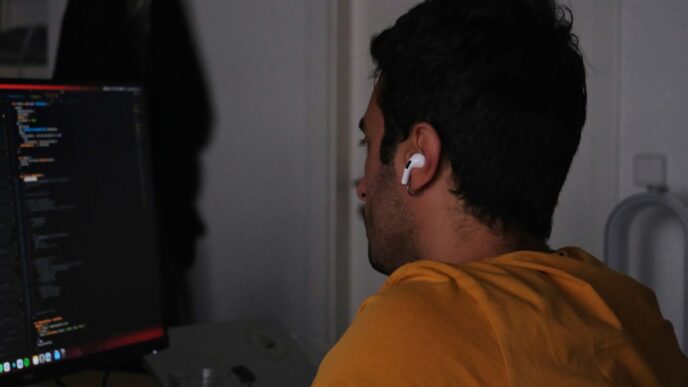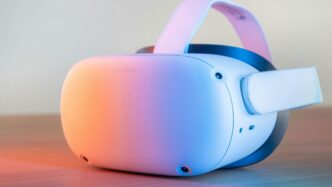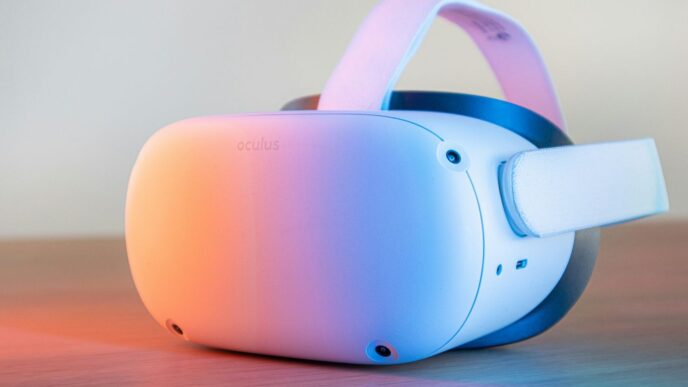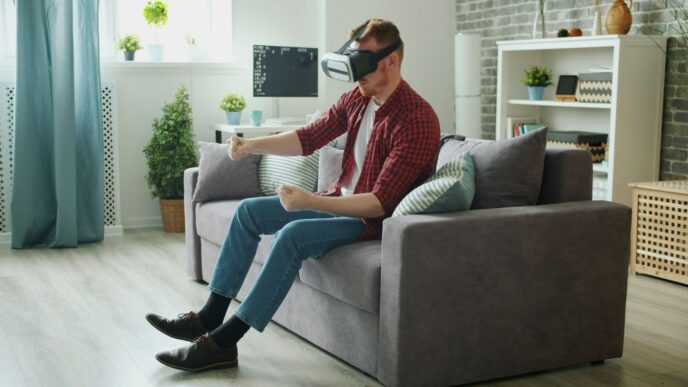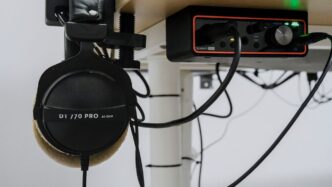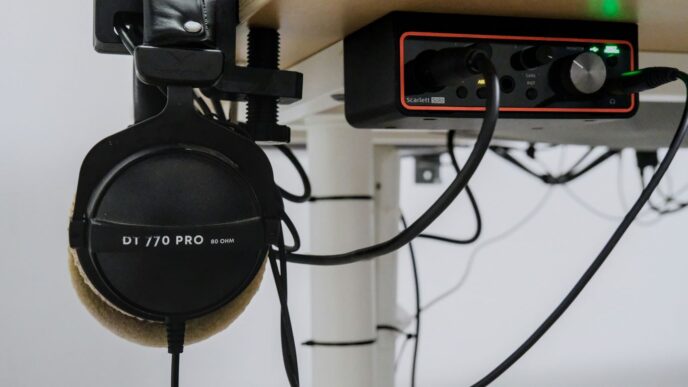So, you’ve got a Quest 3 and a big library of Steam games? That’s awesome! Lots of people think their Quest is just for standalone stuff, but you can totally play those PC VR games right on your headset. It’s not super complicated either. We’re going to walk through how to get your Quest 3 hooked up to your PC so you can jump into SteamVR. Get ready to play some serious games.
Key Takeaways
- Make sure your PC is powerful enough for VR games before you start.
- You can connect your Quest 3 to your PC using a USB-C cable or wirelessly with Air Link.
- Install Steam and SteamVR on your PC, and enable Developer Mode on your Quest 3.
- Launch the Oculus Link app in your headset, then open SteamVR on your PC to pair them.
- Adjust settings in SteamVR and your games for the best performance and battery life.
Connecting Your Quest 3 to Your PC
So, you’ve got your shiny new Quest 3 and you’re itching to play some PC VR games from Steam. That’s totally doable! Your Quest 3 isn’t just a standalone device; it can actually be your window into a much bigger world of gaming when hooked up to your computer. It’s not super complicated, but there are a couple of ways to get it done, and each has its own perks.
Essential Hardware for Quest 3 Steam Link
Before you even think about launching games, let’s talk about what you’ll actually need to make this connection happen. It’s not a ton of stuff, but getting the right bits and pieces makes a big difference.
- A VR-Ready PC: This is the big one. Your computer needs to be powerful enough to run VR games. Steam has a tool called the VR Performance Test that can give you a good idea if your PC is up to snuff. If your PC struggles with regular games, it’s probably going to have a rough time with VR.
- Your Quest 3 Headset: Obviously! Make sure it’s charged up, or at least plugged in, especially if you’re planning a longer gaming session.
- Connection Method: You’ve got two main choices here: a cable or Wi-Fi. We’ll get into the details, but basically, you’ll need either a good USB-C cable or a solid wireless setup.
- The Meta PC App: You’ll need this software installed on your computer. It’s the main way Meta’s headsets talk to your PC.
- Steam and SteamVR: You’ll need Steam installed on your PC, and then you’ll need to grab SteamVR from within Steam. This is what actually lets you run Steam games in VR.
Wired Connection via Oculus Link
This is often the go-to method because it’s generally the most stable and offers the best performance. Think of it like plugging your headset directly into your computer’s graphics card, but through a USB-C cable.
- Get the Meta PC App: If you haven’t already, download and install the Meta Quest PC app on your computer. Log in with your Meta account.
- Plug It In: Grab a quality USB-C cable. You want one that’s designed for data transfer, not just charging. Plug one end into your Quest 3 and the other into a USB port on your PC. A USB 3.0 or higher port is best.
- Enable Oculus Link: Put on your Quest 3 headset. You should see a prompt asking if you want to enable Oculus Link. Go ahead and accept it.
- Launch SteamVR: Once Link is active, open Steam on your PC and then launch SteamVR. Your headset should be recognized, and you’ll be able to see your Steam library within the VR environment.
Wireless Connection via Air Link
If you’re not a fan of cables, Air Link is Meta’s own wireless solution. It uses your Wi-Fi network to stream the game from your PC to your headset. For this to work well, you really need a good Wi-Fi setup.
- Network Requirements: Both your PC and your Quest 3 need to be on the same Wi-Fi network. Ideally, this should be a 5 GHz network, and your PC should ideally be connected to your router via an Ethernet cable. This cuts down on potential wireless interference.
- Enable Air Link on PC: Open the Meta Quest PC app. Go to the ‘Settings’ menu, then find the ‘Beta’ tab, and toggle on ‘Air Link’.
- Enable Air Link on Quest 3: Put on your headset. Go to ‘Settings’, then ‘Experimental Features’, and turn on ‘Air Link’.
- Pairing: Your headset should now search for your PC. Follow the on-screen prompts in the headset to pair them. You might see a code that needs to match.
- Launch SteamVR: Once Air Link is connected and your headset is paired, open SteamVR on your PC. You should now be playing wirelessly!
Setting Up SteamVR for Quest 3
Alright, so you’ve got your Quest 3 all hooked up to your PC, either with a cable or wirelessly. Now it’s time to get SteamVR ready to roll. This part is pretty straightforward, but there are a few things to check to make sure everything runs smoothly.
Ensure Your PC Meets SteamVR Requirements
First things first, your computer needs to be up to snuff for VR. SteamVR can be pretty demanding, so if your PC is a bit older or wasn’t built with gaming in mind, you might run into some choppy performance. You can check Steam’s own VR performance test to get a general idea of how your system stacks up. Generally, you’ll want a decent graphics card, enough RAM, and a processor that can keep up. Think of it like trying to run a marathon – your PC needs the right kind of energy to get through it without getting winded.
Install SteamVR Software on Your PC
If your PC is ready, the next step is getting the SteamVR software itself. This is super easy. Just open up your Steam client on your computer, go to the store, search for ‘SteamVR’, and install it. It’s free, of course. Once it’s downloaded and installed, SteamVR will be ready to go whenever you want to jump into a VR game from your Steam library. It’s the main program that lets your PC talk to your headset for VR stuff.
Enable Developer Mode on Your Quest 3
This is a quick but important step. You need to tell your Quest 3 that it’s okay to connect to your PC for more advanced uses, and that’s what Developer Mode does. To turn it on, you’ll need to use the Meta Quest mobile app on your phone. Open the app, go to your headset’s settings, and find the ‘Developer Mode’ option. Flip that switch on. Once it’s enabled, your Quest 3 is officially ready to be linked up for PCVR gaming.
Launching Steam Games on Quest 3
Alright, so you’ve got your Quest 3 hooked up and SteamVR ready to go. Now comes the fun part: actually playing those Steam games. It’s not super complicated, but there are a few steps to get everything running smoothly.
Launch Oculus Link App on Your Quest 3
First things first, put on your Quest 3. You need to start the Oculus Link application inside the headset. This is the program that acts like a digital bridge, connecting your PC’s power to your headset’s display. You should see a prompt asking if you want to allow access to your Quest 3 data when you plug it in via USB-C or connect wirelessly. Just hit ‘Allow’. This step is pretty straightforward, but it’s the gateway to your PCVR world.
Open SteamVR and Pair with Quest 3
With Oculus Link active in your headset, it’s time to head back to your PC. Open up Steam, and then launch SteamVR. If everything is set up correctly, SteamVR should automatically detect your Quest 3. You might see a message in your headset confirming the connection or asking you to pair. Just follow any on-screen prompts. This is the moment where your Quest 3 officially becomes your VR screen for PC games. It’s pretty cool when it all clicks into place.
Select and Launch Your Desired Steam Game
Now that your headset is talking to SteamVR, you can finally pick a game. Inside SteamVR, you’ll see your library. You can browse through all the VR-compatible titles you own. Just point your controller, select the game you want to play, and hit launch. The game should then load up directly in your Quest 3. It’s that simple! You’re now ready to jump into whatever virtual adventure you’ve chosen.
Optimizing Your Quest 3 Steam Link Experience
Alright, so you’ve got your Quest 3 hooked up to Steam and you’re ready to game. But how do you make sure it all runs smoothly without a hitch? Let’s talk about keeping things running well.
Maintain a Stable Wireless Connection
If you’re going wireless with Air Link, your Wi-Fi is everything. Seriously, a shaky connection means stuttering visuals and lag, which is no fun in VR. Try to keep your Quest 3 and your PC on the same 5 GHz Wi-Fi band. If you can, position your router closer to where you’ll be playing, or even consider a dedicated Wi-Fi 6 router if you’re really serious about this. Some folks even use a dedicated Wi-Fi access point connected directly to their PC via Ethernet, just to cut down on any interference. It sounds like a lot, but a solid connection makes a huge difference.
Keep All Software Updated
This is one of those boring but important things. Make sure your Quest 3’s firmware is up to date, the Meta PC app is current, and Steam and SteamVR are also updated. Developers are always tweaking things to improve performance and fix bugs. You don’t want to be the one stuck with an old version that’s causing problems. Check for updates regularly, it’s usually pretty straightforward.
Adjust In-Game and SteamVR Settings
Not every PC can handle every VR game at max settings, and that’s okay. You’ll want to play around with the graphics settings both in the games themselves and within SteamVR. Lowering settings like resolution scaling, anti-aliasing, or shadow quality can give you a big performance boost. SteamVR has a handy performance graph you can enable to see if you’re dropping frames. Finding that sweet spot between visual quality and smooth gameplay is key. It might take a bit of trial and error, but it’s worth it.
Monitor Headset Battery Life
This one’s pretty simple: keep an eye on your Quest 3’s battery. VR gaming can drain it faster than you might think, especially if you’re using Wi-Fi. If you’re in the middle of an epic boss fight and your headset suddenly dies, that’s a real bummer. Plug it in if you can, or at least have a portable power bank handy if you plan on long gaming sessions. Nobody wants their adventure cut short by a dead battery.
Exploring Advanced Quest 3 PCVR Features
So, you’ve got your Quest 3 hooked up to SteamVR and you’re having a blast. But what else can you do? Turns out, there are a couple of neat tricks to really push your PCVR experience further.
Utilizing Quest Hand Tracking with PCVR
Did you know you can ditch the controllers sometimes? Yep, your Quest 3 has built-in hand tracking, and you can actually use it for some PCVR games. This is still pretty new, so it’s not perfect for every game, but for titles that don’t require super precise button presses or complex inputs, it can be a really cool way to play. Think of games like VRChat or even some simpler exploration titles. It’s a bit of a beta feature, so you might need to have both SteamVR and the Steam Link app on your headset running in their beta versions to get it working. It’s a bit fiddly to set up, but once it’s going, it feels pretty futuristic playing a game just with your hands.
Running Steam Link and SteamVR in Beta
Speaking of beta, sometimes the newest features or performance improvements show up in the beta versions of Steam Link and SteamVR first. If you’re looking to try out things like that hand tracking I just mentioned, or if you’re just curious about what’s coming next, opting into the beta programs can be a good move. It’s not always the most stable experience, mind you. Sometimes things break, or a game might not work quite right. But if you’re okay with a little bit of tinkering and the occasional hiccup, it can give you early access to cool stuff. To get into the beta for SteamVR, you usually go into Steam, find SteamVR in your library, right-click it, go to properties, then betas, and pick the beta update from the dropdown. You’ll likely need to do something similar for the Steam Link app on your headset.
Wrapping Up Your PCVR Journey
So, you’ve made it through the setup, and now the whole Steam library is basically yours to explore on your Quest 3. It’s pretty cool, right? You can play all those big PC games without being stuck in front of your monitor. Whether you went with a cable or decided to cut the cord with Air Link, the important thing is you’re in. Just remember to keep your software updated and maybe tweak those settings if things feel a bit off. Now go have some fun; there are tons of virtual worlds waiting for you.
Frequently Asked Questions
What do I need to play Steam games on my Quest 3?
To play Steam games on your Quest 3, you’ll need a computer that’s strong enough for VR games. You also need the Meta Quest 3 headset, a good USB-C cable for a wired connection, or a fast Wi-Fi network for a wireless one. Make sure you have Steam and SteamVR installed on your PC, and the Meta PC app too.
Can I connect my Quest 3 to my PC with a cable?
Yes, you can connect your Quest 3 to your PC using a USB-C cable. This is called Oculus Link. It’s a reliable way to get a smooth experience because it uses a fast, stable connection.
How does the wireless connection (Air Link) work?
For a wireless connection, called Air Link, both your PC and Quest 3 need to be on the same 5 GHz Wi-Fi network. You’ll need to turn on Air Link in both the Meta PC app and your headset’s settings, then pair them up.
How do I set up SteamVR on my Quest 3?
First, make sure your PC is ready for VR. Then, download and install SteamVR on your PC. You also need to turn on ‘Developer Mode’ in your Quest 3’s settings. This lets your headset talk to your PC for gaming.
How do I start playing a Steam game on my Quest 3?
After connecting and setting up, open the Oculus Link app in your Quest 3. Then, open SteamVR on your PC. Your headset should show up. From there, you can pick any Steam game you want to play in VR.
How can I make my VR gaming experience smoother?
To make things run better, keep your Wi-Fi strong if you’re playing wirelessly. Always update your headset, Steam, and PC software. You can also tweak settings in SteamVR and the games themselves. Don’t forget to check your headset’s battery level so you don’t run out of power mid-game!




